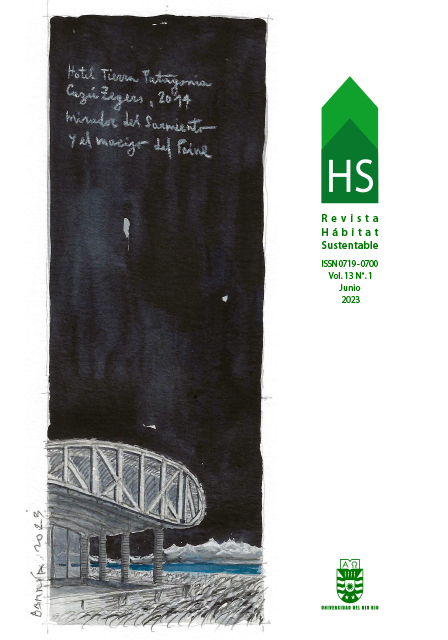Improving the thermal performance of schools in the High Andean Region of Peru. The case of “PRONIED’S prefabricated frost-type modular classrooms”
DOI:
https://doi.org/10.22320/07190700.2023.13.01.05Keywords:
bioclimatic design, passive strategies, thermal performance, energy simulationAbstract
Faced with the qualitative and quantitative deficit of educational infrastructure in Peru’s rural high Andean areas, in recent years the Peruvian State has been investing in and supporting modular solutions, seeking efficiency in the construction processes. The specific proposal, with special emphasis on bioclimatic design, is the "Prefabricated Frost-type Modular Classroom". However, users have been expressing discomfort with these new facilities. This study shows the measurement process carried out on a built module, which allowed calibrating and validating the model using simulation software, to propose improvements in the design that may contribute to future constructions. Taking the adaptive thermal comfort model as a reference, it was confirmed that indoor temperatures were below thermal comfort limits in the early hours of the morning and well above them close to noon, by around 6 ºC and 7 ºC respectively. With the application of complementary bioclimatic strategies, it was possible to considerably improve indoor thermal conditions, although not enough to reach comfort early in the morning. This is because the night-time outdoor temperatures are very low, the building is uninhabited all night long, there is no thermal mass in the envelope, and there are no active solar systems or mechanical air conditioning.
Downloads
References
ASHRAE Standard (2017). Standard 55-2017 Thermal environmental conditions for human occupancy. Ashrae: Atlanta, GA, USA.
CHUI BETANCUR, H. N., HUAQUISTO RAMOS, E., QUISPE, G. B., CANALES GUTIÉRREZ, Á. & CALATAYUD MENDOZA, A. P. (2022). Características de la arquitectura vernácula en zonas altoandinas de Perú. Una contribución al estudio del mundo rural. Cuadernos de Vivienda y Urbanismo, 15, 21-21. DOI: https://doi.org/10.11144/Javeriana.cvu15.cavz
BOS, M. S., GANIMIAN, A. J., VEGAS, E. & ALFONSO M. (2014). Brief Nº13: Perú en PISA 2012 logros y desafíos pendientes. BID. Retrieved from: https://repositorio.minedu.gob.pe/handle/20.500.12799/3814
BURGA, J. (2010). Arquitectura vernácula peruana: un análisis tipológico. Colegio de Arquitectos del Perú.
GENG, Y., JI, W., LIN, B. & ZHU, Y. (2017). The impact of thermal environment on occupant IEQ perception and productivity. Building and Environment, 121, 158-167. DOI: https://doi.org/10.1016/j.buildenv.2017.05.022
GIVONI, B. (1992). Comfort, climate analysis and building design guidelines. Energy and buildings, 18(1), 11-23. DOI: https://doi.org/10.1016/0378-7788(92)90047-K
HAVES, P., RAVACHE, B., FERGADIOTTI, A., KOHLER, C. & YAZDANIAN, M. (2019). Accuracy of HVAC Load Predictions: Validation of EnergyPlus and DOE-2. Using an Instrumented Test Facility. In Proceedings of Building Simulation. DOI: https://doi.org/10.26868/25222708.2019.211268
KÜKRER, E. & ESKIN, N. (2021). Effect of design and operational strategies on thermal comfort and productivity in a multipurpose school building. Journal of Building Engineering, 44, 102697. DOI: https://doi.org/10.1016/j.jobe.2021.102697
MANZANO-AGUGLIARO, F., MONTOYA, F. G., SABIO-ORTEGA, A. & GARCÍA-CRUZ, A. (2015). Review of bioclimatic architecture strategies for achieving thermal comfort. Renewable and Sustainable Energy Reviews, 49, 736-755. DOI: https://doi.org/10.1016/j.rser.2015.04.095
MAZZEO, D., MATERA, N., CORNARO, C., OLIVETI, G., ROMAGNONI, P. & DE SANTOLI, L. (2020). EnergyPlus, IDA ICE and TRNSYS predictive simulation accuracy for building thermal behaviour evaluation by using an experimental campaign in solar test boxes with and without a PCM module. Energy and Buildings, 212, 109812. DOI: https://doi.org/10.1016/j.enbuild.2020.109812
MOLINA, J. R., LEFEBVRE, G., ESPINOZA, R., HORN, M. & GÓMEZ, M. M. (2021). Bioclimatic approach for rural dwellings in the cold, high Andean region: A case study of a Peruvian house. Energy and Buildings, 231, 110605. DOI: https://doi.org/10.1016/j.enbuild.2020.110605
Programa Nacional de Infraestructura Educativa, PRONIED del Ministerio de Educación, MINEDU (2021). Ficha de Homologación de Módulo Prefabricado Aula tipo Heladas. Retrieved from: https://www.gob.pe/institucion/pronied/campa%C3%B1as/4440-fichas-de-homologacion-de-modulos-prefabricados
SÁEZ, E., & CANZIANI, J. (2020). Vernacular architecture and cultural landscapes in the Sondondo Valley (Peru). The International Archives of Photogrammetry, Remote Sensing and Spatial Information Sciences, 44(M1), 175-180. DOI: https://doi.org/10.5194/isprs-archives-XLIV-M-1-2020-175-2020
SZOKOLAY, S. (2012). Introduction to architectural science. Routledge. DOI:
https://doi.org/10.4324/9780080473130
TORRES PUÑEZ, C. M. (2021). Construyendo la educación: infraestructura como determinante del rendimiento académico en el Perú 2000-2015. [Thesis for the degree of Economist, Universidad de Lima]. Retrieved from: https://hdl.handle.net/20.500.12724/13874
TREMBLAY, J. C. & AINSLIE, P. N. (2021). Global and country-level estimates of human population at high altitude. Proceedings of the National Academy of Sciences, 118(18), e2102463118. DOI: https://doi.org/10.1073/pnas.2102463118
VIDAL, J. P. (2014). Las ocho regiones naturales del Perú. Terra Brasilis Revista da Rede Brasileira de História da Geografia e Geografia Histórica, (3). DOI: https://doi.org/10.4000/terrabrasilis.1027
WARGOCKI, P., PORRAS-SALAZAR, J. A. & CONTRERAS-ESPINOZA, S. (2019). The relationship between classroom temperature and children’s performance in school. Building and Environment, 157, 197-204. DOI: https://doi.org/10.1016/j.buildenv.2019.04.046
WIESER, M., RODRÍGUEZ-LARRAÍN, S. & ONNIS, S. (2021). Bioclimatic strategies for high altitude tropical cold climate. Prototype validation in Orduña, Puno, Perú. Estoa. Revista de la Facultad de Arquitectura y Urbanismo de la Universidad de Cuenca, 10(19), 09-19. DOI: https://doi.org/10.18537/est.v010.n019.a01
ZOMORODIAN, Z. S., TAHSILDOOST, M. & HAFEZI, M. (2016). Thermal comfort in educational buildings: A review article. Renewable and Sustainable Energy Reviews, 59, 895-906. DOI: https://doi.org/10.1016/j.rser.2016.01.033
Downloads
Published
How to Cite
Issue
Section
License
Copyright (c) 2023 Martin Wieser, Antonio Garaycochea, Varinia Prada

This work is licensed under a Creative Commons Attribution-ShareAlike 4.0 International License.
The content of articles which are published in each edition of Habitat Sustentable, is the exclusive responsibility of the author(s) and does not necessarily represent the thinking or compromise the opinion of University of the Bio-Bio.
The author(s) conserve their copyright and guarantee to the journal, the right of first publication of their work. This will simultaneously be subject to the Creative Commons Recognition License CC BY-SA, which allows others to share-copy, transform or create new materials from this work for non-commercial purposes, as long as they recognize authorship and the first publication in this journal, and its new creations are under a license with the same terms.











 Scientific Information Program/Concurso Fondos de Publicación de Revistas Científicas 2018/ Proyecto Mejoramiento de Visibilidad de Revistas UBB (Código:FP180007).
Scientific Information Program/Concurso Fondos de Publicación de Revistas Científicas 2018/ Proyecto Mejoramiento de Visibilidad de Revistas UBB (Código:FP180007).





